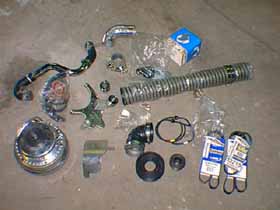| The image at right is a picture of all the parts included in the Nelson package. You
can see the Paxton unit, the aluminum mounting bracket, the fuel pressure riser, the new serpentine pulleys and belts, the
top radiator tube (with aluminum water neck) and the new throttlebody elbow and horn. Also included are the flexible
airpipe from the air filter, the rubber elbow for the supercharger intake, as well as a heat shield for the front sixport. |
 |